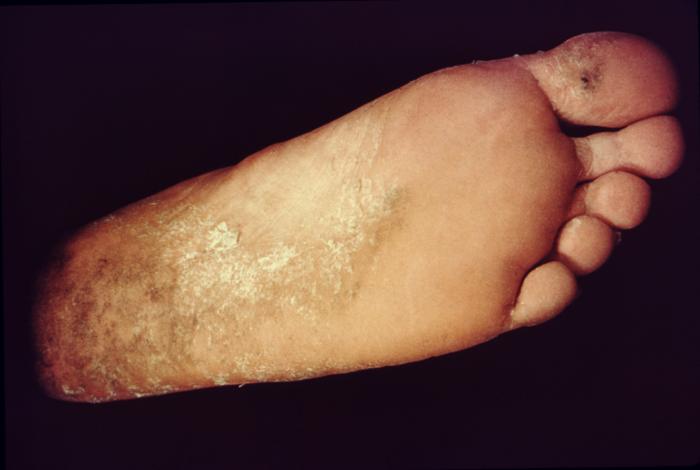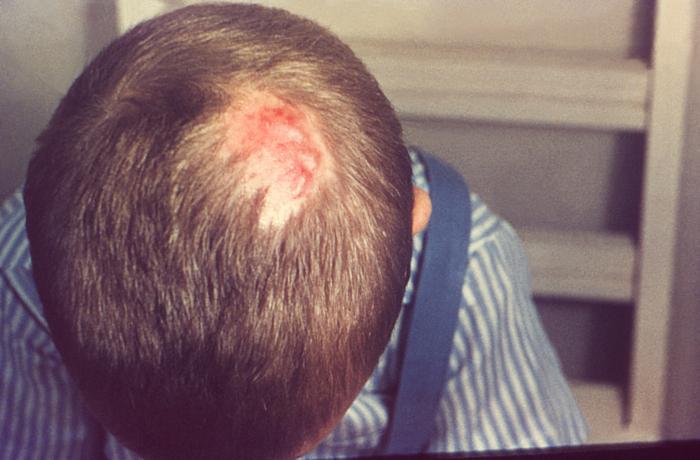Ringworm
Report a Case
Disease Reporting Line:
(808) 586-4586
About This Disease
Ringworm is a common infection of the skin and nails caused by fungus. It is called “ringworm” because it can cause a red, itchy, circular rash that looks like a ring. Ringworm is also called “tinea.” The different types of ringworm are usually named for where they are on the body. There are about 40 different species of fungi that can cause ringworm.
Areas of the body that can be infected by ringworm:
- Feet (athlete’s foot)
- Groin, inner thighs, or buttocks (jock itch)
- Scalp
- Beard
- Hands
- Toenails or fingernails
- Other parts of the body such as arms or legs
Signs and Symptoms
General symptoms of ringworm are itchy skin, ring-shaped rash, red, scaly, cracked skin, and hair loss. Symptoms typically begin 4 to 14 days after the skin comes in contact with the fungi that cause ringworm.
Symptoms of ringworm by location on the body:
- Feet (athlete’s foot): red, swollen, peeling, itchy skin between the toes (especially between the pinky toe and the toe next to it). The soles and heels can also have symptoms. The skin on the feet can blister in severe cases.
- Scalp: scaly, itchy, red circular bald spot on the scalp. The bald spot can grow in size and if the infection spreads, multiple spots can develop. Ringworm on the scalp is more common in children than adults.
- Groin (jock itch): scaly, itchy red spots usually on the inner sides of the skin folds of the thigh
- Beard: scaly, itchy, red spots on the cheeks, chin and upper neck. The spots may become crusted over or fill with pus and the affected hair might fall out.
Transmission
You can get ringworm from direct skin-to-skin contact. There are three main ways that ringworm can be transmitted:
- From another person who has ringworm. Direct contact to an infected person, and contact with clothing, towels, combs, or other personal items from the infected person.
- From an animal that has ringworm. Contact with an infected animal, including dogs and cats, especially kittens and puppies, cows, goats, pigs, and horses.
- From the environment. The fungi can live on surfaces, especially in damp areas like locker rooms and showers
Diagnosis
Your doctor can diagnose ringworm by looking at your skin and asking about symptoms. They may take a small skin scraping to look at under a microscope or send it to a laboratory for a fungal culture.
Treatment
Ringworm on the skin can be treated with over-the-counter cream, lotions, or powders such as:
- Clotrimazole (Lotrimin, Mycelex)
- Miconazole (Aloe Vesta Antifungal, Azolen, Baza Antifungal, Carrington Antifungal, Critic Aid Clear, Cruex Prescription Strength, DermaFungal, Desenex, Fungoid Tincture, Micaderm, Micatin, Micro-Guard, Miranel, Mitrazol, Podactin, Remedy Antifungal, Secura Antifungal)
- Terbinafine (Lamisil)
- Ketoconazole (Xolegel)
Ringworm on the scalp usually needs to be treated with an oral prescription of antifungal such as:
- Griseofulvin (Grifulvin V, Gris-PEG)
- Terbinafine
- Itraconazole (Onmel, Sporanox)
- Fluconazole (Diflucan)
If your symptoms get worse or don’t go away, contact your doctor.
Risk in Hawaii
There are no statistics on how many people have been infected with ringworm in Hawaii. Children under 12 years seem to get ringworm of the scalp more often than adults.
Prevention
- Keep your skin clean and dry
- Wear shoes that aren’t too tight and allows air to circulate freely around your feet
- Don’t walk barefoot in locker rooms or public showers
- Keep fingernails and toenails short and clean
- Change your socks and underwear at least once a day
- Don’t share clothing, towels, sheets or other personal items with someone who has ringworm
- Wash your hands with soap and water after playing with pets. Take your pets to the veterinarian if you think they are infected with ringworm
- For athletes, shower immediately after practice or a game and keep all your equipment and uniforms clean. Don’t share equipment with other players.




